对象
对象, 在C语言是如何实现的?
Python中对象分为两类: 定长(int等), 非定长(list/dict等)
所有对象都有一些相同的东西, 源码中定义为PyObject和PyVarObject, 两个定义都有一个共同的头部定义PyObject_HEAD(其实PyVarObject有自己的头部定义PyObject_VAR_HEAD, 但其实际上用的也是PyObject_HEAD).
源码位置: Include/object.h
PyObject_HEAD
Python 内部, 每个对象拥有相同的头部.
定义
/* PyObject_HEAD defines the initial segment of every PyObject. */ #define PyObject_HEAD \ _PyObject_HEAD_EXTRA \ Py_ssize_t ob_refcnt; \ struct _typeobject *ob_type;
说明
1. _PyObject_HEAD_EXTRA
先忽略, 双向链表结构, 后面垃圾回收再说
2. Py_ssize_t ob_refcnt
Py_ssize_t在编译时确定, 整型
ob_refcnt, 引用计数, 跟Python的内存管理机制相关(基于引用计数的垃圾回收)
3. struct _typeobject *ob_type
*ob_type 指向类型对象的指针(指向_typeobject结构体)
决定了这个对象的类型!
PyObject
定义
typedef struct _object {
PyObject_HEAD
} PyObject;
说明
1. 依赖关系
PyObject -> PyObject_HEAD
结构
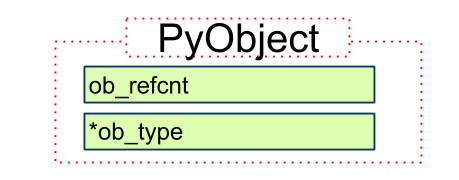
PyVarObject
定义
typedef struct {
PyObject_VAR_HEAD
} PyVarObject;
#define PyObject_VAR_HEAD \
PyObject_HEAD \
Py_ssize_t ob_size; /* Number of items in variable part */
说明
1. 依赖关系
PyVarObject -> PyObject_VAR_HEAD -> PyObject_HEAD
2.Py_ssize_t ob_size
ob_size, 变长对象容纳的元素个数
结构
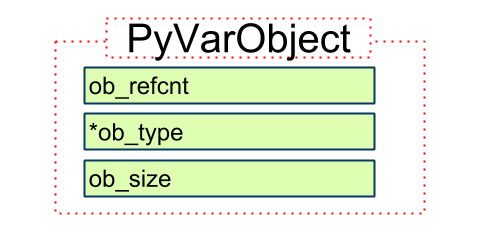
代码关系
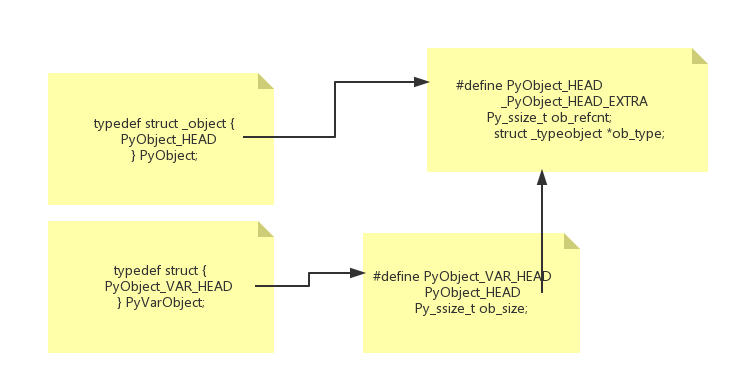
几个方法
跟对象相关的方法
#define Py_REFCNT(ob) (((PyObject*)(ob))->ob_refcnt)
读取引用计数
#define Py_TYPE(ob) (((PyObject*)(ob))->ob_type)
获取对象类型
#define Py_SIZE(ob) (((PyVarObject*)(ob))->ob_size)
读取元素个数(len)
跟引用计数相关的方法
Py_INCREF(op) 增加对象引用计数
Py_DECREF(op) 减少对象引用计数, 如果计数位0, 调用_Py_Dealloc
_Py_Dealloc(op) 调用对应类型的 tp_dealloc 方法(每种类型回收行为不一样的, 各种缓存池机制, 后面看)
其他
几个参数涉及
ob_refcnt 引用计数, 与内存管理/垃圾回收相关
ob_type 类型, 涉及Python的类型系统
类型
一个例子
>>> a = 1 >>> a 1 >>> type(a) <type 'int'> #等价的两个 >>> type(type(a)) <type 'type'> >>> type(int) <type 'type'> #还是等价的两个 >>> type(type(type(a))) <type 'type'> >>> type(type(int)) <type 'type'>
我们反向推导一个int对象是怎么生成的.
1. 首先, 定义一种类型叫PyTypeObject
代码位置 Include/object.h
定义
typedef struct _typeobject {
/* MARK: base, 注意, 是个变长对象*/
PyObject_VAR_HEAD
const char *tp_name; /* For printing, in format "<module>.<name>" */ //类型名
Py_ssize_t tp_basicsize, tp_itemsize; /* For allocation */ // 创建该类型对象时分配的内存空间大小
// 一堆方法定义, 函数和指针
/* Methods to implement standard operations */
printfunc tp_print;
hashfunc tp_hash;
/* Method suites for standard classes */
PyNumberMethods *tp_as_number; // 数值对象操作
PySequenceMethods *tp_as_sequence; // 序列对象操作
PyMappingMethods *tp_as_mapping; // 字典对象操作
// 一堆属性定义
....
} PyTypeObject;
说明
1. PyObject_VAR_HEAD
变长对象
2. const char *tp_name
tp_name, 类型名字符串数组
所有Type都是PyTypeObject的"实例": PyType_Type/PyInt_Type
2. 然后, 用PyTypeObject初始化得到一个对象PyType_Type
代码位置 Objects/typeobject.c
定义
PyTypeObject PyType_Type = {
PyVarObject_HEAD_INIT(&PyType_Type, 0)
"type", /* tp_name */
sizeof(PyHeapTypeObject), /* tp_basicsize */
sizeof(PyMemberDef), /* tp_itemsize */
(destructor)type_dealloc, /* tp_dealloc */
// type对象的方法和属性初始化值
.....
};
说明
1. tp_name
类型名, 这里是"type"
2. PyVarObject_HEAD_INIT(&PyType_Type, 0)
PyVarObject_HEAD_INIT, 这个方法在 Include/object.h中,
等价于
ob_refcnt = 1
*ob_type = &PyType_Type
ob_size = 0
即, PyType_Type的类型是其本身!
结构
第一张图, 箭头表示实例化(google doc用不是很熟找不到对应类型的箭头)
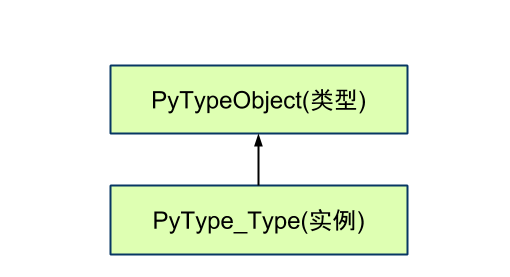
第二张图, 箭头表示指向
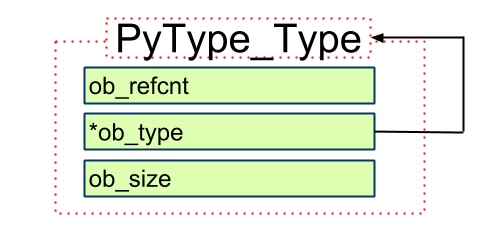
使用
# 1. int 的 类型 是`type` >>> type(int) <type 'type'> # 2. type 的类型 还是`type`, 对应上面说明第二点 >>> type(type(int)) <type 'type'>
注意: 无论任何时候, ob_type指向的是 PyTypeObject的实例: PyType_Type/PyInt_Type...
3. 再然后, 定义具体的类型, 这里以PyInt_Type为例子
代码位置 Objects/intobject.c
定义
PyTypeObject PyInt_Type = {
PyVarObject_HEAD_INIT(&PyType_Type, 0)
"int",
sizeof(PyIntObject),
0,
// int类型的相关方法和属性值
....
(hashfunc)int_hash, /* tp_hash */
};
说明
1. "int"
PyInt_Type的类型名是int
2.PyVarObject_HEAD_INIT(&PyType_Type, 0)
PyInt_Type的
*ob_type = &PyType_Type
结构

使用
>>> type(1) <type 'int'> >>> type(type(1)) <type 'type'>
4. 最后, 生成一个整数对象int
代码位置 Include/intobject.h
定义
typedef struct {
PyObject_HEAD
long ob_ival;
} PyIntObject;
结构
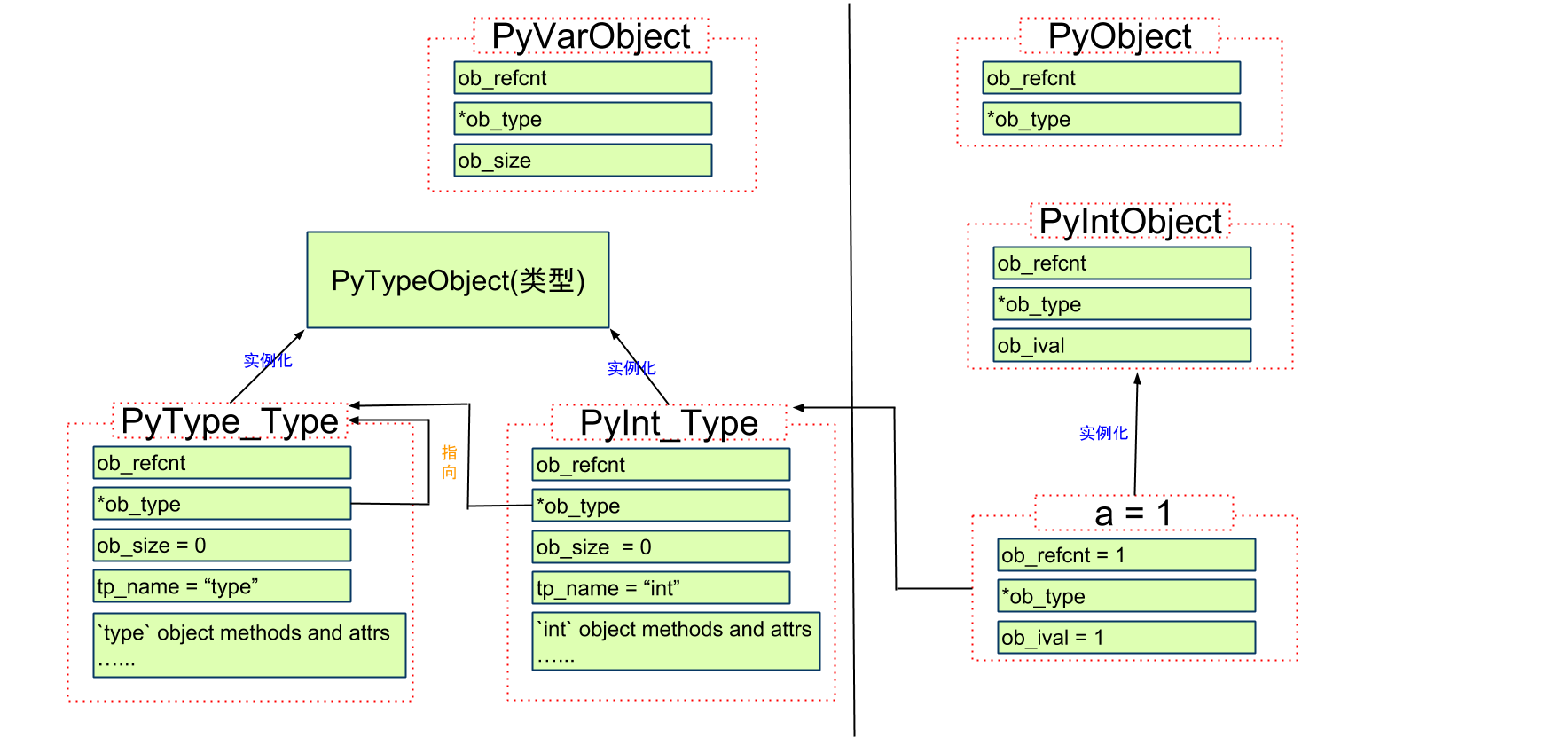
 Wie werden Arrays im wissenschaftlichen Computer mit Python verwendet?Apr 25, 2025 am 12:28 AM
Wie werden Arrays im wissenschaftlichen Computer mit Python verwendet?Apr 25, 2025 am 12:28 AMArraysinpython, besondersvianumpy, arecrucialInScientificComputingFortheirefficience undvertilität.1) Sie haben festgelegt, dass die Fornerikerne, Datenanalyse und Machinelarning.2) Numpy'SimplementationIncensuresFasteroperationsdanpythonlisten.3) Araysensableableableableableableableableableableableableableableableableableableableableableableableableableable
 Wie gehen Sie mit verschiedenen Python -Versionen im selben System um?Apr 25, 2025 am 12:24 AM
Wie gehen Sie mit verschiedenen Python -Versionen im selben System um?Apr 25, 2025 am 12:24 AMSie können verschiedene Python -Versionen mithilfe von Pyenv, Venv und Anaconda verwalten. 1) Verwalten Sie PYENV, um mehrere Python -Versionen zu verwalten: Installieren Sie PyEnv, setzen Sie globale und lokale Versionen. 2) Verwenden Sie VenV, um eine virtuelle Umgebung zu erstellen, um Projektabhängigkeiten zu isolieren. 3) Verwenden Sie Anaconda, um Python -Versionen in Ihrem Datenwissenschaftsprojekt zu verwalten. 4) Halten Sie das System Python für Aufgaben auf Systemebene. Durch diese Tools und Strategien können Sie verschiedene Versionen von Python effektiv verwalten, um den reibungslosen Betrieb des Projekts zu gewährleisten.
 Was sind einige Vorteile bei der Verwendung von Numpy -Arrays gegenüber Standard -Python -Arrays?Apr 25, 2025 am 12:21 AM
Was sind einige Vorteile bei der Verwendung von Numpy -Arrays gegenüber Standard -Python -Arrays?Apr 25, 2025 am 12:21 AMNumpyarrayShaveseveraladVantagesOverStandardPythonArrays: 1) SiearemuchfasterDuetoc-basiert, 2) sie istaremoremory-effizient, insbesondere mit mit LaShlargedatasets und 3) sie können sich mit vektorisierten Funktionsformathematical und Statistical opertical opertical opertical operticaloperation, Making
 Wie wirkt sich die homogene Natur der Arrays auf die Leistung aus?Apr 25, 2025 am 12:13 AM
Wie wirkt sich die homogene Natur der Arrays auf die Leistung aus?Apr 25, 2025 am 12:13 AMDer Einfluss der Homogenität von Arrays auf die Leistung ist doppelt: 1) Homogenität ermöglicht es dem Compiler, den Speicherzugriff zu optimieren und die Leistung zu verbessern. 2) aber begrenzt die Typ -Vielfalt, was zu Ineffizienz führen kann. Kurz gesagt, die Auswahl der richtigen Datenstruktur ist entscheidend.
 Was sind einige Best Practices für das Schreiben von ausführbaren Python -Skripten?Apr 25, 2025 am 12:11 AM
Was sind einige Best Practices für das Schreiben von ausführbaren Python -Skripten?Apr 25, 2025 am 12:11 AMTocraftexecutablePythonScripts, folge theseBestPractices: 1) addashebangline (#!/Usr/bin/envpython3) tomakethescriptexcutable.2 SetPermissions withchmod xyour_script.py.3) organisation -bithacleardocstringanduseInname == "__ __": FormAcleardocstringanduseInname
 Wie unterscheiden sich Numpy Arrays von den Arrays, die mit dem Array -Modul erstellt wurden?Apr 24, 2025 pm 03:53 PM
Wie unterscheiden sich Numpy Arrays von den Arrays, die mit dem Array -Modul erstellt wurden?Apr 24, 2025 pm 03:53 PMNumpyarraysarebetterFornumericaloperations und multi-dimensionaldata, whilethearraymoduleiStableforbasic, an Gedächtniseffizienten
 Wie vergleichen sich die Verwendung von Numpy -Arrays mit der Verwendung der Array -Modularrays in Python?Apr 24, 2025 pm 03:49 PM
Wie vergleichen sich die Verwendung von Numpy -Arrays mit der Verwendung der Array -Modularrays in Python?Apr 24, 2025 pm 03:49 PMNumpyarraysarebetterforeheavynumericalComputing, während der projectwithsimpledatatypes.1) numpyarraysoferversatility und -PerformanceForlargedataSets und Compoxexoperations.2) thearraysoferversStility und Mächnory-Effefef
 Wie bezieht sich das CTypes -Modul auf Arrays in Python?Apr 24, 2025 pm 03:45 PM
Wie bezieht sich das CTypes -Modul auf Arrays in Python?Apr 24, 2025 pm 03:45 PMctypesallowscreatingandmanipulationsc-stylearraysinpython.1) usectypestoInterfaceWithClibraryForperformance.2) createCec-stylearraysFornumericalComputationen.3) PassarrayStocfunctionsFectionFicecher-Operationen.


Heiße KI -Werkzeuge

Undresser.AI Undress
KI-gestützte App zum Erstellen realistischer Aktfotos

AI Clothes Remover
Online-KI-Tool zum Entfernen von Kleidung aus Fotos.

Undress AI Tool
Ausziehbilder kostenlos

Clothoff.io
KI-Kleiderentferner

Video Face Swap
Tauschen Sie Gesichter in jedem Video mühelos mit unserem völlig kostenlosen KI-Gesichtstausch-Tool aus!

Heißer Artikel

Heiße Werkzeuge

SublimeText3 Mac-Version
Codebearbeitungssoftware auf Gottesniveau (SublimeText3)

mPDF
mPDF ist eine PHP-Bibliothek, die PDF-Dateien aus UTF-8-codiertem HTML generieren kann. Der ursprüngliche Autor, Ian Back, hat mPDF geschrieben, um PDF-Dateien „on the fly“ von seiner Website auszugeben und verschiedene Sprachen zu verarbeiten. Es ist langsamer und erzeugt bei der Verwendung von Unicode-Schriftarten größere Dateien als Originalskripte wie HTML2FPDF, unterstützt aber CSS-Stile usw. und verfügt über viele Verbesserungen. Unterstützt fast alle Sprachen, einschließlich RTL (Arabisch und Hebräisch) und CJK (Chinesisch, Japanisch und Koreanisch). Unterstützt verschachtelte Elemente auf Blockebene (wie P, DIV),

SAP NetWeaver Server-Adapter für Eclipse
Integrieren Sie Eclipse mit dem SAP NetWeaver-Anwendungsserver.

SublimeText3 Linux neue Version
SublimeText3 Linux neueste Version

EditPlus chinesische Crack-Version
Geringe Größe, Syntaxhervorhebung, unterstützt keine Code-Eingabeaufforderungsfunktion






